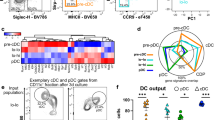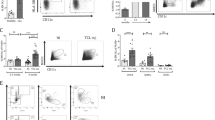Abstract
Dendritic cells (DCs) are professional antigen-presenting cells with the ability to induce primary T-cell responses. They are commonly produced by culturing monocytes in the presence of IL-4 and GM-CSF (cells produced in this manner are called conventional DCs). Here we report the generation of two functionally distinct subsets of DCs derived from programmable cells of monocytic origin (PCMOs) in the presence of IL-3 or tumor necrosis factor alpha (TNF-α). Monocytes were treated with macrophage colony-stimulating factor (M-CSF) and IL-3 for 6 days and then incubated with IL-4 and IL-3 (for IL-3 DCs) or with IL-4, GM-CSF and TNF-α (for TNF-α DCs) for 7 days. Monocytes were then loaded with tumor lysate (used as antigen), and poly (I∶C) was added. The maturation factors TNF-α and monocyte conditioned medium (MCM) were added on days 4 and 5, respectively. The phenotypes of the DCs generated were characterized by flow cytometry, and the cells' phagocytic activities were measured using FITC-conjugated latex bead uptake. T-cell proliferation and cytokine release were assayed using MTT and commercially available ELISA kits, respectively. We found that either IL-3DCs or TNF-α DCs induce T-cell proliferation and cytokine secretion; the cytokine release pattern showed reduced IL-12/IL-10 and IFN-γ/IL-4 ratios in both types of DCs and in DC-primed T-cell supernatant, respectively, which confirmed that the primed T cells were polarized toward aTh2-type immune response. We concluded that PCMOs are a new cell source that can develop into two functionally distinct DCs that both induce a Th2-type response in vitro. This modality can be used as a DC-based immunotherapy for autoimmune diseases.
This is a preview of subscription content, access via your institution
Access options
Subscribe to this journal
Receive 12 digital issues and online access to articles
$119.00 per year
only $9.92 per issue
Buy this article
- Purchase on Springer Link
- Instant access to full article PDF
Prices may be subject to local taxes which are calculated during checkout











Similar content being viewed by others
References
Palucka K, Banchereau J . Cancer immunotherapy via dendritic cells. Nat Rev Cancer 2012; 12: 265–277.
Kah-Wai L, Jacek T, Jacek R . Dendritic cells heterogeneity and its role in cancer immunity. J Cancer Res Ther 2006; 2: 35–42.
Liu K, Nussenzweig MC . Origin and development of dendritic cells. Immunol Rev 2010; 234: 45–54.
Moore AJ, Anderson MK . Dendritic cell development: a choose-your-own-adventure story. Adv Hematol 2013; 2013: 949513.
Whiteside TL, Odoux C . Dendritic cell biology and cancer therapy. Cancer Immunol Immunother 2004; 53: 240–248.
Ardavín C, Martínez del Hoyo G, Martín P, Anjuère F, Arias CF, Marín AR et al. Origin and differentiation of dendritic cells. Trends Immunol 2001; 22: 691–700.
Chen W, Antonenko S, Sederstrom JM, Liang X, Chan ASH, Kanzler H et al. Thrombopoietin cooperates with FLT3-ligand in the generation of plasmacytoid dendritic cell precursors from human hematopoietic progenitors. Blood 2004; 103: 2547–2553.
Ebrahimi M, Hassan ZM, Hadjati J, Hayat P, Moazzeni SM . Immediate exposure to TNF-alpha activate dendritic cells derived from non-purified cord blood mononuclear cells. Iran J Immunol 2009; 6: 107–118.
Landi A, Babiuk LA, van Drunen Littel-van den Hurk S . Dendritic cells matured by a prostaglandin E2-containing cocktail can produce high levels of IL-12p70 and are more mature and Th1-biased than dendritic cells treated with TNF-α or LPS. Immunobiology 2011; 216: 649–662.
Naik SH, O'Keeffe M, Proietto A, Shortman HHK, Wu L . CD8+, CD8−, and plasmacytoid dendritic cell generation in vitro using flt3 ligand. Methods Mol Biol 2010; 595: 167–176.
Jopling C, Boue S, Belmonte JCI . Dedifferentiation, transdifferentiation and reprogramming: three routes to regeneration. Nat Rev Mol Cell Biol 2011; 12: 79–89.
Dresske B, El Mokhtari NE, Ungefroren H . Ruhnke M, Plate V, Janssen D et al. Multipotent cells of monocytic origin improve damaged heart function. Am J Transplant 2006; 6: 947–958.
Hyder A, Ehnert S, Hinz H, Nüssler AK, Fändrich F, Ungefroren H . EGF and HB-EGF enhance the proliferation of programmable cells of monocytic origin (PCMO) through activation of MEK/ERK signaling and improve differentiation of PCMO-derived hepatocyte-like cells. Cell Commun Signal 2012; 10: 23–29.
Ruhnke M, Ungefroren H, Nussler A, Martin F, Brulport M, Schormann W et al. Differentiation of in vitro-modified human peripheral blood monocytes into hepatocyte-like and pancreatic islet-like cells. Gastroenterology 2005; 128: 1774–1786.
Zhao Y, Glesne D, Huberman E . A human peripheral blood monocyte-derived subset acts as pluripotent stem cells. Proc Natl Acad Sci USA 2003; 100: 2426–2431.
Delirezh N, Moazzeni SM, Shokri F, Shokrgozar MA, Atri M, Kokhaei P . Autologous dendritic cells loaded with apoptotic tumor cells induce T cell-mediated immune responses against breast cancer in vitro. Cell Immunol 2009; 257: 23–31.
GanjiBakhsh M, Nejati V, Delirezh N, Asadi M, Gholami K . Mixture of fibroblast, epithelial and endothelial cells conditioned media induce monocyte-derived dendritic cell maturation. Cell Immunol 2011; 272: 18–24.
Böyum A . Separation of leukocytes from blood and bone marrow; Introduction. Scand J Clin Lab Invest Suppl 1968; 97: 7–11.
Li YL, Wu YG, Wang YQ, Li Z, Wang RC, Wang L et al. Bone marrow-derived dendritic cells pulsed with tumor lysates induce anti-tumor immunity against gastric cancer ex vivo. World J Gastroenterol 2008; 14: 7127–7135.
Grouard G, Rissoan MC, Filgueira L, Durand I, Banchereau J, Liu YJ . The enigmatic plasmacytoid T cells develop into dendritic cells with interleukin (IL)-3 and CD40-ligand. J Exp Med 1997; 185: 1101–1112.
Pufe T, Petersen W, Fandrich F, Varoga D, Wruck CJ, Mentlein R et al. Programmable cells of monocytic origin (PCMO): a source of peripheral blood stem cells that generate collagen type II-producing chondrocytes. J Orthop Res 2008; 26: 304–313.
Ungefroren H, Fändrich F . The programmable cell of monocytic origin (PCMO): a potential adult stem/progenitor cell source for the generation of islet cells. Adv Exp Med Biol 2010; 654: 667–682.
Buelens C, Bartholomé EJ, Amraoui Z, Boutriaux M, Salmon I, Thielemans K et al. Interleukin-3 and interferon β cooperate to induce differentiation of monocytes into dendritic cells with potent helper T-cell stimulatory properties. Blood 2002; 99: 993–998.
Ebner S, Hofer S, Fürhapter C, Herold M, Fritsch P, Heufler C et al. A novel role for IL-3: human monocytes cultured in the presence of IL-3 and IL-4 differentiate into dendritic cells that produce less IL-12 and shift Th cell responses toward a Th2 cytokine pattern. J Immunol 2002; 168: 6199–6207.
Bryder D, Rossi DJ, Weissman IL . Hematopoietic stem cells: the paradigmatic tissue-specific stem cell. Am J Pathol 2006; 169: 338–346.
Craig W, Kay R, Cutler RL, Lansdorp PM . Expression of Thy-1 on human hematopoietic progenitor cells. J Exp Med 1993; 177: 1331–1342.
Friedman AD . Transcriptional regulation of granulocyte and monocyte development. Oncogene 2002; 21: 3377.
Majeti R, Park CY, Weissman IL . Identification of a hierarchy of multipotent hematopoietic progenitors in human cord blood. Stem Cell 2007; 1: 635–645.
Hubo M, Trinschek B, Kryczanowsky F, Tuettenberg A, Steinbrink K, Jonuleit H . Costimulatory molecules on immunogenic versus tolerogenic human dendritic cells. Front Immunol 2013; 4: 82–91.
Lenschow DJ, Walunas TL, Bluestone JA . CD28/B7 system of T cell costimulation. Annu Rev Immunol 1996; 14: 233–258.
de Smedt T, Pajak B, Muraille E, Lespagnard L, Heinen E, de Baetselier P et al. Regulation of dendritic cell numbers and maturation by lipopolysaccharide in vivo. J Exp Med 1996; 184: 1413–1424.
Hartmann G, Weiner GJ, Krieg AM . CpG DNA: a potent signal for growth, activation, and maturation of human dendritic cells. Proc Natl Acad Sci USA 1999; 96: 9305–9310.
Xing F, Wang J, Hu M, Yu Y, Chen G, Liu J . Comparison of immature and mature bone marrow-derived dendritic cells by atomic force microscopy. Nanoscale Res Lett 2011; 6: 1–9.
Delirezh N, Shojaeefar E, Parvin P, Asadi B . Comparison the effects of two monocyte isolation methods, plastic adherence and magnetic activated cell sorting methods, on phagocytic activity of generated dendritic cells. Cell J 2013; 15: 218–223.
Boonstra A, Rajsbaum R, Holman M, Marques R, Asselin-Paturel C, Pereira JP et al. Macrophages and myeloid dendritic cells, but not plasmacytoid dendritic cells, produce IL-10 in response to MyD88- and TRIF-dependent TLR signals, and TLR-independent signals. J Immunol 2006; 177: 7551–7558.
Ngoi SM, Tovey MG, Vella AT . Targeting poly (I:C) to the TLR3-independent pathway boosts effector CD8 T cell differentiation through IFN-α/β. J Immunol 2008; 181: 7670–7680.
Smits HH, de Jong EC, Wierenga EA, Kapsenberg ML . Different faces of regulatory DCs in homeostasis and immunity. Trends Immunol 2005; 26: 123–129.
Acknowledgements
This work was supported by the Institute of Biotechnology of Urmia University (IBUU), Grant No. 8-D-92. We thank Professor Andreas Nüssler, Dr Mahmood Bozorgmehr and Dr Reza Habibian for technical advice; Mr Asghar Aliyari and Mr Yousef Heidar Sani (Immunology Laboratory, Veterinary School of Urmia University, Urmia, Iran) and Mr Ehsan Janzamin and Mr FazelSamani (Department of Stem Cell, Flow Cytometry Laboratory, Royan Institute, Tehran, Iran) for technical assistance; and Mr Yones Najafi Darmian and the other volunteers in this study.
Author information
Authors and Affiliations
Corresponding author
Rights and permissions
About this article
Cite this article
Beikzadeh, B., Delirezh, N. Phenotypic and functional comparison of two distinct subsets of programmable cell of monocytic origin (PCMOs)-derived dendritic cells with conventional monocyte-derived dendritic cells. Cell Mol Immunol 13, 160–169 (2016). https://doi.org/10.1038/cmi.2014.135
Received:
Revised:
Accepted:
Published:
Issue Date:
DOI: https://doi.org/10.1038/cmi.2014.135
Keywords
This article is cited by
-
The synergistic and enhancive effects of IL-6 and M-CSF to expand and differentiate functional dendritic cells from human monocytes under serum-free condition
Journal of Biological Engineering (2023)



